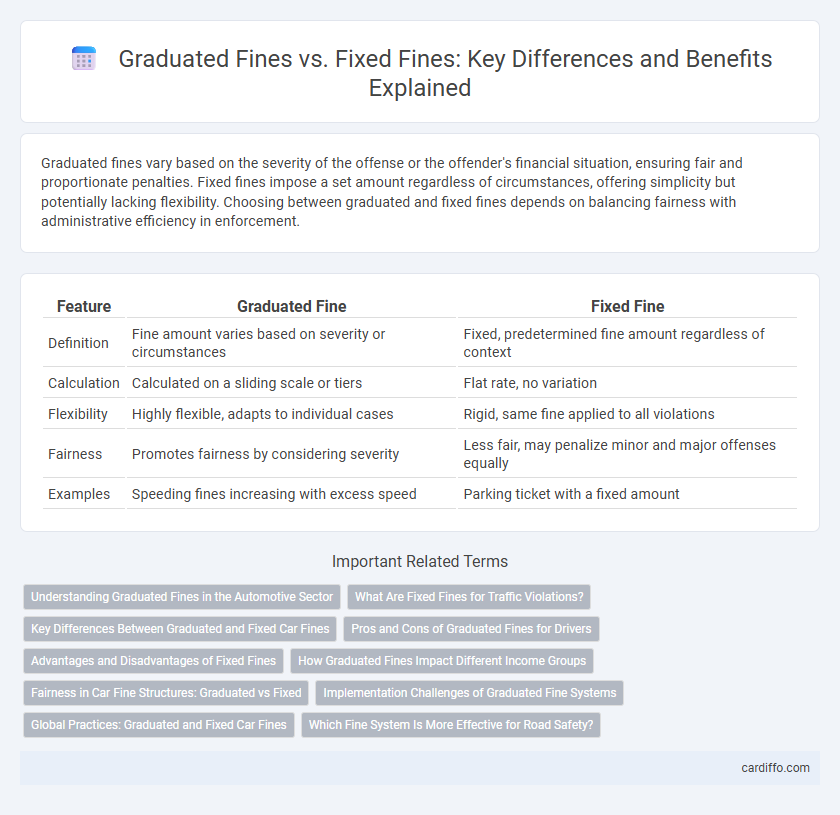Graduated fines vary based on the severity of the offense or the offender's financial situation, ensuring fair and proportionate penalties. Fixed fines impose a set amount regardless of circumstances, offering simplicity but potentially lacking flexibility. Choosing between graduated and fixed fines depends on balancing fairness with administrative efficiency in enforcement.
Table of Comparison
| Feature | Graduated Fine | Fixed Fine |
|---|---|---|
| Definition | Fine amount varies based on severity or circumstances | Fixed, predetermined fine amount regardless of context |
| Calculation | Calculated on a sliding scale or tiers | Flat rate, no variation |
| Flexibility | Highly flexible, adapts to individual cases | Rigid, same fine applied to all violations |
| Fairness | Promotes fairness by considering severity | Less fair, may penalize minor and major offenses equally |
| Examples | Speeding fines increasing with excess speed | Parking ticket with a fixed amount |
Understanding Graduated Fines in the Automotive Sector
Graduated fines in the automotive sector vary based on the severity of the violation, allowing penalties to increase progressively with repeated or more serious infractions, unlike fixed fines which impose a set amount regardless of circumstances. This system incentivizes compliance by scaling financial consequences according to the extent of non-compliance, such as emissions violations or safety breaches. Understanding the graduated fine structure helps automotive manufacturers and drivers better assess risks and encourage adherence to regulations.
What Are Fixed Fines for Traffic Violations?
Fixed fines for traffic violations are predetermined monetary penalties set by law for specific offenses such as speeding, running a red light, or illegal parking. These fines provide a standard and immediate consequence without the need for court appearances, ensuring efficient enforcement and consistent punishment. The amount of a fixed fine is typically based on the severity of the violation and is listed in traffic regulation schedules.
Key Differences Between Graduated and Fixed Car Fines
Graduated fines adjust the penalty amount based on the severity or frequency of the violation, offering a flexible scale that increases with repeated offenses or higher risk behavior. Fixed fines impose a set monetary penalty regardless of circumstances, providing a straightforward, predictable cost for specific infractions. Key differences include graduated fines promoting deterrence through escalating consequences, while fixed fines ensure consistency and simplicity in enforcement and payment.
Pros and Cons of Graduated Fines for Drivers
Graduated fines offer a flexible approach to traffic penalties by scaling the amount based on the severity and frequency of offenses, which encourages safer driving habits and deters repeat violations. This system can be more equitable, avoiding overly harsh penalties for minor infractions while imposing stricter consequences for serious or repeated breaches. However, graduated fines may increase administrative complexity and require consistent enforcement to ensure fairness and effectiveness across diverse driver populations.
Advantages and Disadvantages of Fixed Fines
Fixed fines provide a clear, predetermined penalty amount that simplifies enforcement and reduces administrative costs, enhancing efficiency in legal and regulatory processes. However, their rigidity may result in disproportionate penalties that fail to consider the severity or context of the offense, potentially undermining fairness. The fixed fine system often lacks flexibility, which can lead to public dissatisfaction and reduce the deterrent effect for more serious violations.
How Graduated Fines Impact Different Income Groups
Graduated fines adjust penalties based on an individual's income, ensuring that higher earners pay proportionally more than lower-income individuals, promoting fairness in financial burdens. This system reduces the disproportionate impact on low-income groups, preventing fines from becoming punitive rather than corrective. By aligning fines with income levels, graduated fines create a more equitable legal framework that supports social justice and financial responsibility.
Fairness in Car Fine Structures: Graduated vs Fixed
Graduated fines adjust penalties based on the severity or frequency of the offense, promoting fairness by aligning punishment with individual circumstances and reducing disproportionate impacts on low-income drivers. Fixed fines apply a uniform penalty regardless of context, which can lead to inequities and financial hardship for some individuals. Studies indicate that graduated fine structures enhance compliance and equity by addressing the socioeconomic differences among offenders.
Implementation Challenges of Graduated Fine Systems
Implementation challenges of graduated fine systems include accurately assessing offenders' financial capacity to ensure fairness and proportionality, which requires comprehensive income verification mechanisms. Administrative complexities arise from the need to categorize violators based on variable income levels, increasing the burden on judicial and enforcement agencies. Ensuring consistency and transparency in fine calculations is critical to maintain public trust and avoid perceptions of bias or favoritism.
Global Practices: Graduated and Fixed Car Fines
Global practices in car fines vary between graduated and fixed systems, with graduated fines increasing penalties based on severity or repeat offenses, promoting proportional deterrence. Countries like Finland and Australia implement graduated fines to address reckless driving by scaling penalties according to driver history and violation type. Fixed fines, common in nations such as Singapore and Japan, apply uniform charges for specific infractions, ensuring consistency and predictability in traffic law enforcement.
Which Fine System Is More Effective for Road Safety?
Graduated fine systems adjust penalties based on the severity and frequency of traffic violations, promoting greater compliance by imposing higher costs on repeat offenders and serious infractions. Fixed fine systems offer a standard penalty regardless of context, which may lead to reduced deterrence and insufficient motivation for behavior change. Studies indicate that graduated fines are more effective for road safety by targeting high-risk drivers and encouraging responsible driving habits through escalating consequences.
Graduated Fine vs Fixed Fine Infographic

 cardiffo.com
cardiffo.com